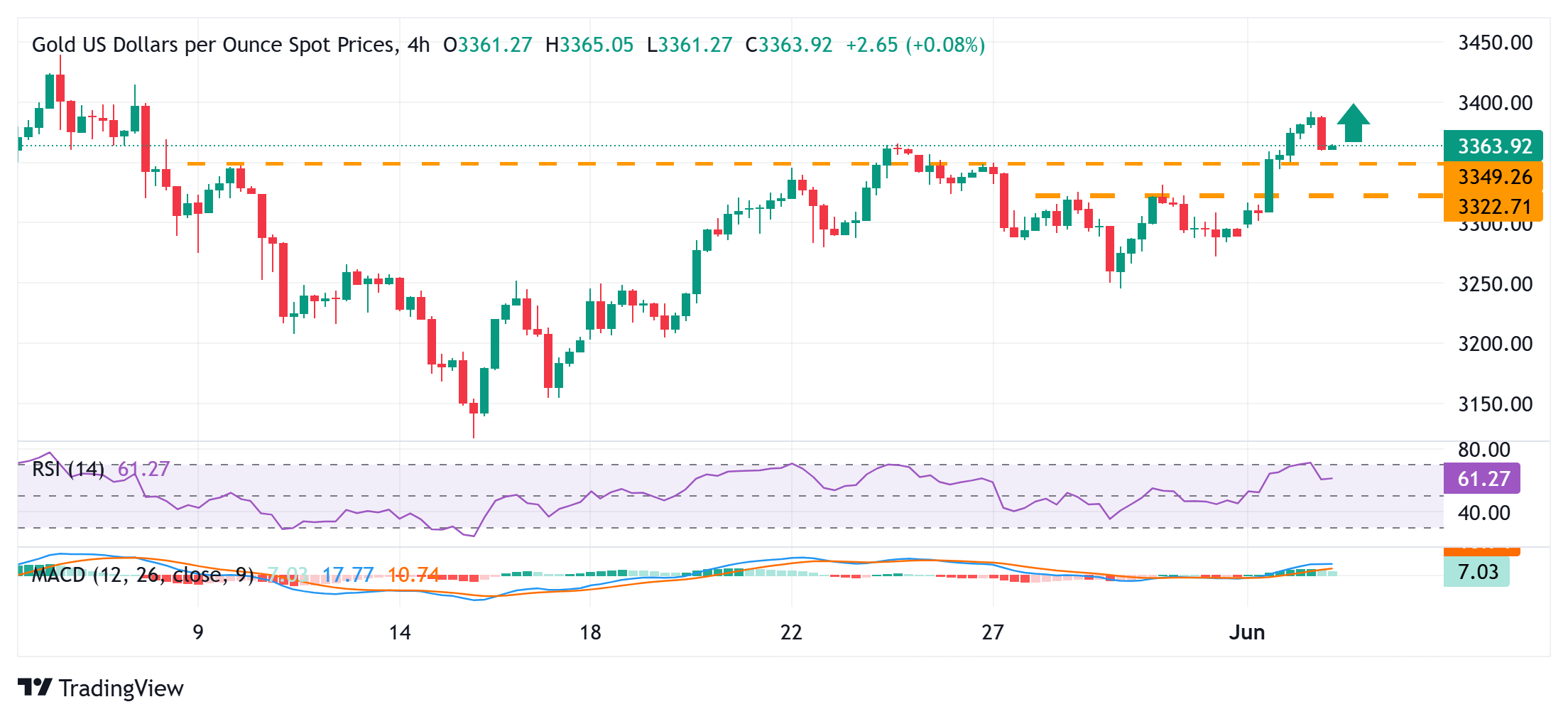- Gold price attracts some intraday sellers amid a modest USD rebound from a multi-week low.
- Fed rate cut bets and US fiscal concerns should keep a lid on further USD appreciation.
- Rising geopolitical tensions and trade-related uncertainties should support the XAU/USD pair.
Gold price (XAU/USD) retreats from the vicinity of the $3,400 round-figure mark, or a nearly four-week peak touched during the Asian session on Tuesday and erodes a part of the previous day’s strong gains. A modest US Dollar (USD) recovery from the lowest level since April 22 is seen as a key factor exerting some pressure on the commodity. Apart from this, a generally positive tone around the equity markets seems to undermine demand for the safe-haven precious metal.
However, persistent trade-related uncertainties and rising geopolitical tensions might keep a lid on any optimism in the markets. Adding to this, bets that the Federal Reserve (Fed) will lower borrowing costs again, along with concerns about the worsening US fiscal condition, should cap any meaningful USD appreciation and help limit deeper losses for the Gold price. This, in turn, warrants some caution for the XAU/USD bears and positioning for a further intraday downfall.
Daily Digest Market Movers: Gold price drifts lower but downside seems cushioned by unabated tensions
- The US Dollar rebounds from a six-week low and prompts some profit-taking around the Gold price on Tuesday, following the previous day’s move higher. Most Asian equity markets took positive cues from the stronger overnight close on Wall Street and exerted additional pressure on the safe-haven precious metal.
- Investors, however, remained largely on edge in the wake of rising US-China trade tensions and geopolitical risks. US President Donald Trump lashed out at China over the weekend and accused the latter of violating a preliminary tariff agreement, reviving fears of a trade war between the world’s two largest economies.
- Earlier last week, Trump announced that he is going to double tariffs on steel imports from 25% to 50%. Meanwhile, the Trump administration is reportedly urging countries to present their most favorable trade proposals by Wednesday in an effort to speed up discussions before reciprocal tariffs come into effect on July 8.
- A second round of direct peace talks between Ukrainian and Russian delegations in Istanbul on Monday ended without a major breakthrough. Moreover, Ukrainian President Volodymyr Zelenskyy said the surprise drone attacks over the weekend were a success and that it will continue if Russia doesn’t halt its offensive.
- The developments have heightened geopolitical risks, which might continue to weigh on investors’ sentiment and offer some support to the safe-haven XAU/USD. Furthermore, bets for at least two 25 basis points interest rate cuts by the Federal Reserve in 2025 should limit losses for the non-yielding yellow metal.
- Comments from several Fed officials in recent days have brought some clarity to the outlook for interest rate cuts in 2025. In fact, Fed Governor Christopher Waller said on Monday that rate cuts remain possible later this year even with the Trump administration’s tariffs likely to push up price pressures temporarily.
- Moreover, Chicago Fed President Austan Goolsbee noted that interest rates can come down over 12-18 months. In contrast, Dallas Fed President Lorie Logan struck a cautious tone and said that the policy is well positioned to wait and be patient, and the risk is if higher short-term inflation expectations become entrenched.
- Nevertheless, investors seem convinced that the Fed will stick to its easing bias amid signs of further easing of inflationary pressure in the US. Adding to this concerns about the US fiscal health could revive the “sell America” theme, which, in turn, warrants caution for the USD bulls and should benefit the commodity.
- Traders now look forward to the release of the US JOLTS Job Openings data, which, along with speeches by influential FOMC members, will drive the USD and the XAU/USD pair. The focus, however, will remain on the US monthly employment details, or the Nonfarm Payrolls (NFP) report on Friday.
Gold price dip below $3,355 resistance-turned-support could be a buying opportunity

From a technical perspective, the overnight breakout through the $3,324-3,326 hurdle and a subsequent strength beyond the $3,355 area was seen as a key trigger for the XAU/USD bulls. Moreover, oscillators on daily/hourly charts are holding comfortably in positive territory and suggest that the path of least resistance for the Gold price is to the upside. Hence, any subsequent slide below the $3,355 area could be seen as a buying opportunity and remain limited near the $3,326-3,324 resistance-turned-support. Some follow-through selling, however, could make the commodity vulnerable to weakening further below the $3,300 mark and testing the $3,286-3,285 horizontal support.
On the flip side, bulls might now wait for a move beyond the $3,400 round figure before positioning for a move toward the next relevant resistance near the $3,430-3,432 area. A sustained strength beyond the latter should allow the Gold price to retest the all-time peak touched in April and make a fresh attempt to conquer the $3,500 psychological mark.
Gold FAQs
Gold has played a key role in human’s history as it has been widely used as a store of value and medium of exchange. Currently, apart from its shine and usage for jewelry, the precious metal is widely seen as a safe-haven asset, meaning that it is considered a good investment during turbulent times. Gold is also widely seen as a hedge against inflation and against depreciating currencies as it doesn’t rely on any specific issuer or government.
Central banks are the biggest Gold holders. In their aim to support their currencies in turbulent times, central banks tend to diversify their reserves and buy Gold to improve the perceived strength of the economy and the currency. High Gold reserves can be a source of trust for a country’s solvency. Central banks added 1,136 tonnes of Gold worth around $70 billion to their reserves in 2022, according to data from the World Gold Council. This is the highest yearly purchase since records began. Central banks from emerging economies such as China, India and Turkey are quickly increasing their Gold reserves.
Gold has an inverse correlation with the US Dollar and US Treasuries, which are both major reserve and safe-haven assets. When the Dollar depreciates, Gold tends to rise, enabling investors and central banks to diversify their assets in turbulent times. Gold is also inversely correlated with risk assets. A rally in the stock market tends to weaken Gold price, while sell-offs in riskier markets tend to favor the precious metal.
The price can move due to a wide range of factors. Geopolitical instability or fears of a deep recession can quickly make Gold price escalate due to its safe-haven status. As a yield-less asset, Gold tends to rise with lower interest rates, while higher cost of money usually weighs down on the yellow metal. Still, most moves depend on how the US Dollar (USD) behaves as the asset is priced in dollars (XAU/USD). A strong Dollar tends to keep the price of Gold controlled, whereas a weaker Dollar is likely to push Gold prices up.

